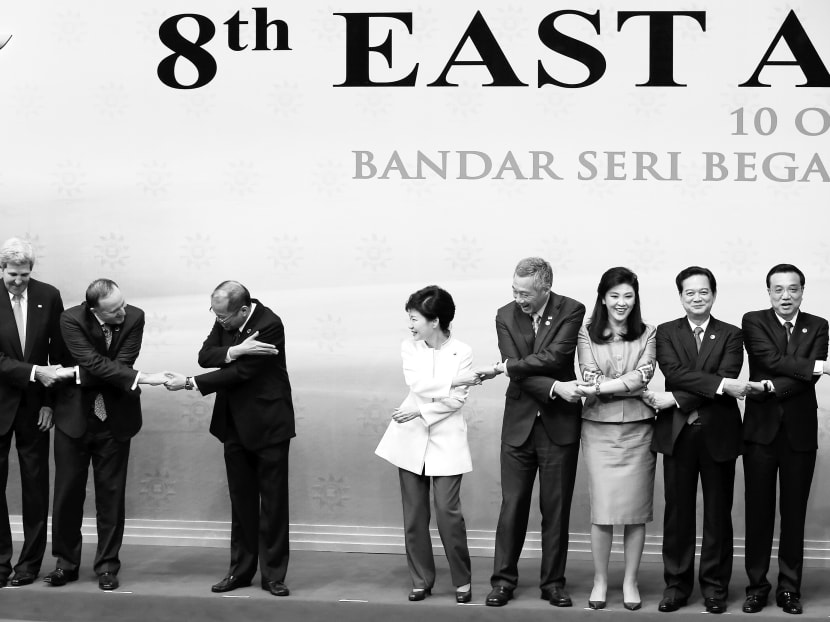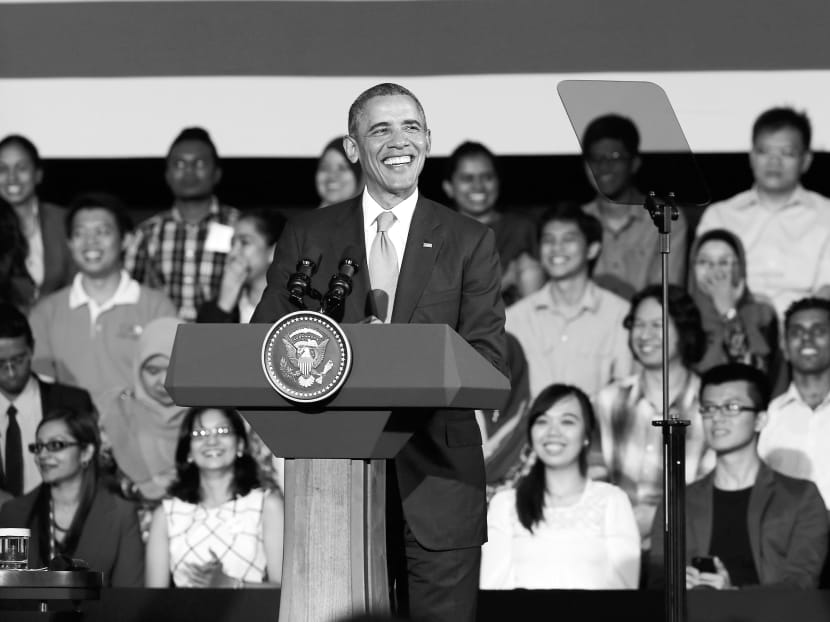US and South-east Asia are partners for a shared future
Leading American think-tank Brookings Institution has launched a Lee Kuan Yew Chair in South-east Asia Studies to enable in-depth policy research regarding South-east Asia. Minister for Foreign Affairs K Shanmugam and United States National Security Adviser Susan Rice attended the launch at the Washington-based institute on Monday. In his remarks, Mr Shanmugam said it was timely to launch the programme, as the success of countries in the region has created a dynamism that has generated new challenges and opportunities. In turn, Ms Rice said South-east Asia would remain a central focus of the US’ rebalance to Asia. She also reiterated Washington’s commitment to the economic growth and security throughout the region. Here is an excerpt of her speech:


Leading American think-tank Brookings Institution has launched a Lee Kuan Yew Chair in South-east Asia Studies to enable in-depth policy research regarding South-east Asia. Minister for Foreign Affairs K Shanmugam and United States National Security Adviser Susan Rice attended the launch at the Washington-based institute on Monday. In his remarks, Mr Shanmugam said it was timely to launch the programme, as the success of countries in the region has created a dynamism that has generated new challenges and opportunities. In turn, Ms Rice said South-east Asia would remain a central focus of the US’ rebalance to Asia. She also reiterated Washington’s commitment to the economic growth and security throughout the region. Here is an excerpt of her speech:
I’m honoured to be here with Foreign Minister Shanmugam. President Barack Obama and I met Prime Minister Lee Hsien Loong at the White House a few months ago to affirm the excellent partnership between Singapore and the US. And I think it’s fitting that Brookings’ new Chair in South-east Asian Studies is named after Singapore’s founding father — a man who has played such a key role in shaping the region’s growth — Mr Lee Kuan Yew.
In many ways, Singapore embodies the arc of development that nations across South-east Asia are achieving. The people of South-east Asia are increasingly connected — to one another and to the global economy. Entrenched dictatorships have given way to new democracies, and throughout the region, citizens are playing a greater role in their government and civil life. As President Obama said in Malaysia earlier this year, perhaps no region on earth has changed so dramatically during the past several decades.
With this change comes growing influence and greater opportunities to engage on the world stage. Asia’s rise in global affairs is due in no small part to South-east Asia’s contributions. That’s why the nations of South-east Asia are and will remain a central focus of America’s rebalance to Asia. We see them as equal partners in our mission to advance a vision that promotes growth and development, bolsters the security of nations, strengthens democratic governance and advances human rights for all people.
President Obama will continue this work when he visits the region again in November, including stops in China to participate in Asia-Pacific Economic Cooperation (APEC), Myanmar for the East Asia Summit and Australia for the Group of Twenty meeting.
DEEPENING TRADE AND SECURITY TIES
South-east Asia and its markets are critical to America’s prosperity. Together, the Association of South-east Asian Nations (ASEAN) comprises the seventh-largest economy in the world and the fourth-largest trading partner for the US. ASEAN nations draw more US investment than any single country in Asia. And with some of the fastest-growing economies in the world, ASEAN will only become more important to our economic future.
That’s why we’re committed to completing the Trans-Pacific Partnership (TPP). One-third of TPP participants are from ASEAN, including members like Singapore, Vietnam and Malaysia, for which the high-standard agreement means making serious new commitments. But this agreement will deliver tremendous benefits to all our economies and we are committed to helping our partners meet the TPP’s requirements and realising the opportunities for greater trade and investment that come with it.
We’re working to deepen our trade and investment ties with the region. In June, Commerce Secretary Penny Pritzker led a delegation of American business leaders to the Philippines, Vietnam and Myanmar to explore new commercial opportunities. US Trade Representative Michael Froman met all his ASEAN counterparts in Myanmar last month. Together, we’re promoting growth that is broad-based and sustainable, so economies can compete on an equal footing and prosperity is shared among citizens at every level of society.
Equally, South-east Asia plays a vital role in maintaining peace and stability throughout Asia. We have long-standing alliances with Thailand and the Philippines, as well as an important security partnership with Singapore. In April, President Obama and President Benigno Aquino of the Philippines announced a new Enhanced Defence Cooperation Agreement, which will strengthen cooperation between our militaries. We’re also enhancing our security cooperation with nations like Malaysia and Vietnam, including by improving their capacity to contribute to maritime security.
We continue to work with nations in the region on challenges that none of us can meet alone. This includes addressing borderless threats like climate change, responding to humanitarian crises like last year’s super-typhoon, countering violent extremism and peacefully resolving maritime disputes among neighbours.
To support cooperative solutions to these challenges, the US has made historic investments to strengthen the region’s institutions, including ASEAN. President Obama hosted the first US-ASEAN leaders meeting in 2009, and it’s now an annual event. The President sent our first resident Ambassador to ASEAN, and the Senate just confirmed Nina Hachigian to fill the post in the coming years.
This increased engagement with ASEAN has already delivered substantial benefits, including improved coordination in responding to natural disasters, growing investment in developing the region’s infrastructure and green energy sources and rapidly expanding cooperation on maritime safety and security.
A COMMON VISION FOR THE FUTURE
We’re also building partnerships directly with the people of the region. We’re doing this through programmes like the Lower Mekong Initiative, which helps strengthen communities’ ability to provide their own healthcare, educate their children and protect their environment.
In Cambodia, the United States Agency for International Development (USAID) is working with the local authorities to improve school enrolment among young children. In Indonesia, the Millennium Challenge Corporation is helping villages raise incomes while reducing their dependence on fossil fuels.
And through President Obama’s Young South-east Asian Leaders Initiative, we are helping young people across the region build their skills and connect them to the resources they need to serve their communities, create new businesses and become the next generation of leaders.
In April, President Obama hosted a remarkable town hall with many of these young people in Malaysia. There were entrepreneurs, activists and advocates — all of them impressive and thoughtful young people, and each determined to forge a brighter future. They wanted to know not only how they could become stronger leaders, but also how to bridge gaps of culture, language and belief to unite a region as diverse as South-east Asia, so it can to achieve its full potential.
That’s a goal we share — because South-east Asia is brimming with enormous potential. It’s also facing serious questions about how to adapt, as several major powers become more active in the region. China’s rise, Japan’s re-emergence, India’s revival and, of course, America’s rebalance — these dynamics are real and they converge squarely in South-east Asia.
But these trends ought to be an opportunity for greater cooperation, not just competition. South-east Asian nations should not have to choose sides among major powers, particularly when it comes to the US and China. Preserving the independence and sovereignty of all our partners in the region is at the heart of our policy towards South-east Asia.
To be sure, America’s relationship with China is important to the future of both our nations, the region and the world. I just travelled to China a couple weeks ago and met their senior leaders. In November, President Obama will again meet President Xi Jinping to continue deepening our cooperation on major regional and global challenges — building a relationship that allows us to work together on shared interests and talk frankly about areas where we disagree, including human rights.
At the same time, we continue to build stronger bilateral relationships with the nations of South-east Asia and to work together as equals in multilateral fora so individual nations can preserve their independence while fostering a group dynamic that reinforces collective norms and prevents large states from pressuring smaller ones.
That’s another reason we’ve focused on strengthening Asia’s regional institutions, like the East Asia Summit. We want to build and reinforce habits that encourage collaboration — to establish a common set of rights as well as responsibilities that ultimately ensures a level playing field for all.
All the challenges I’ve discussed today require sustained attention, and even in the press of world events—ongoing conflicts in the Middle East, heightened tensions with Russia over Ukraine, an Ebola epidemic ravaging West Africa — the US commitment to Asia and to South-east Asia, in particular, remains a priority.
The US is a Pacific nation. Our shared future is as certain as our shared past. And the people of the US and those of South-east Asia share a common vision for that future — a future where daughters and sons can go to school and reach confidently for their dreams; where anyone can start a business and have a fair shot to succeed; where fundamental rights can never be restricted or denied.
That’s what we’ve been building towards for the past five years. That’s why we’ve worked so closely together in pursuit of shared goals — whether we’re securing the sea lanes of the Pacific or delivering relief in the wake of natural disasters.
With each year, the ties between our peoples grow stronger. And as we continue working together towards our shared future, the US will remain a reliable partner and true friend to all the people of the region.






